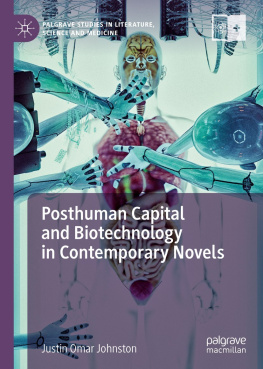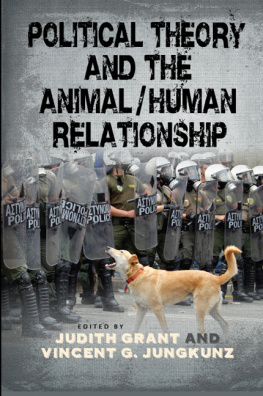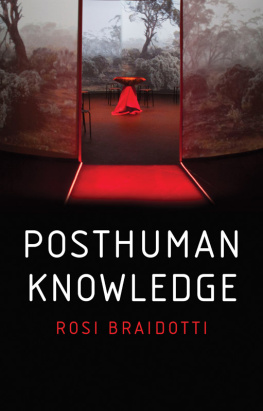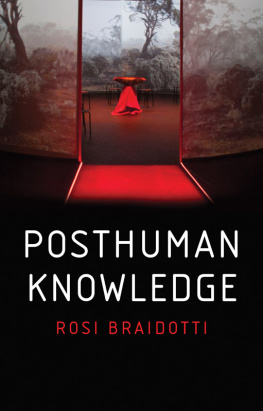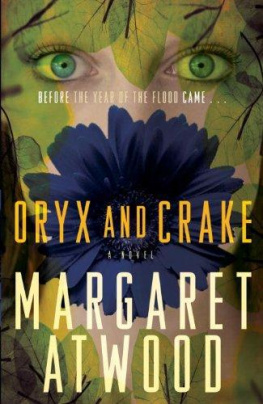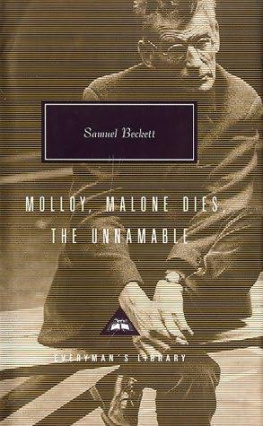1. Introduction: The Biotech Century, Human Capital, and Genre
The twenty-first century has been widely hailed as the biotech century by scientists such as Ian Wilmut, E.O. Wilson, and Craig Venter; by historians such as Francis Fukuyama; by journalists in cover stories for Time and The Economist , and by investors speculating on breakthroughs in somatic cell nuclear transfer (SCNT), regenerative medicine, synthetic biology, and CRISPR-Cas9 genetic engineering. Posthuman Capital addresses several distinctive literary figurations of so-called posthuman embodimentthe human clone, the animal-human hybrid, the toxic body, and the digital-humanthat have proliferated across a range of internationally acclaimed novels during the biotech century. By probing the potentials and limitations of biotechnology, these novels draw attention to the entanglement of bodies within particular environments, economic networks, and ecological settings. Moving beyond the fear and excitement elicited by new developments in biotechnology, these works not only recall biotechnologys roots in twentieth-century biopolitics, but they also anticipate still emergent forms of posthuman and transhuman embodiment. While the major novels my book examines (Kazuo Ishiguros Never Let Me Go , Margaret Atwoods Oryx and Crake , Indra Sinhas Animals People , and Jeanette Wintersons The Stone Gods ) represent a range of contemporary authors with unique literary projects, these novels all locate fleshy bodies as critical meeting places for technology and social subjectivity. Taken together, these works depict a prosthetic society where technological changes in reproduction, labour, mobility, kinship, surveillance, and ecological stability transform traditional humanist institutions.
In other words, the novels I examine all anticipate a pointedly contemporary problem: the sticky merging of flesh and technology combined with our increasing dependence on technologically based networks for the reproduction of social identities. If Michel Foucault diagnosed human individuality as a symptom of disciplinary institutions where architectural enclosures (such as prisons, hospitals, and schools) constructed fixed subject positions, then these contemporary novels figure biotech as a form of mobile discipline on-the-go that expands beyond institutional walls and across diverse, but technologically connected, urban landscapes. In the novels I examine, small mobile technologies (such as cell phones, debit cards, and Viagra pills) become wet prosthetics which not only travel intimately alongside bodies, but also link these bodies to dispersed technological networks capable of programming new forms of hybrid subjectivity.
While calling these emerging figures posthuman helps us mark an historical shift away from disciplinary humanism and its dominant definitions of modern man, I contend that posthuman is ultimately an imperfect and misleading term for describing many of the hybrid bodies that appear in contemporary literature. Rather, in this book, I seek to foreground the role that human capital theory has played in the formulation of neoliberal subjects as never-human-enough. I argue that neoliberal rationalities reimagine human belonging as an aspirational category always and structurally just out of reach. Posthuman Capital , therefore, highlights a series of characters who are highly motivated to be more human, to quote Reeboks latest advertising campaign (). In the context of neoliberalism, this directive to become more human is a call to appreciate ones human capital or to upgrade ones body through various biotechnical self-investments. Critically, however, if one can always become more human, then one can never, finally, become human enough or fully human.
Finally, Posthuman Capital not only investigates the prosthetic entanglement of various bodies and technological networks within the novels I examine; it also explores how these novels connect readers to speculative and emerging futures. Rather than emphasizing aesthetic reflection or synthetic integration, these novels offer prosthetic narratives that link together two irreducible and interdependent genres of futurity: the dystopian and the post-apocalyptic. Many contemporary dystopian narratives, I argue, posit new surveillance technologies as an organizing node around which the centripetal forces of political control and social inequality develop. Alternatively, post-apocalyptic narratives often hinge on the fatal inability of institutions and networks to effectively manage the centrifugal threats posed by non-human forces, particularly viruses, toxins, and climates. Drawing on the Greek prefix pros, meaning toward and in addition to, prosthetic novels orient readers toward futures framed as extensions or additions to the recognizable present. These works show how fears of apocalyptic disorder become alibis for dystopian control, while also illustrating how this control precipitates planetary and social disasters. By not subsuming one genre to the other, these prosthetic novels reveal and interrupt the mutual dependencies which allow these two genres of futurity to function in tandem like an engine that drives cultural attitudes and expectations about the unwelcome future.
Divided into three sections, this introduction begins by exploring the scientific, political, and legal narratives that have helped frame the twenty-first century as the biotech century, particularly in the United States and the United Kingdom. Although many of these narratives have shifted in response to major developments in bioscience, the story of a biotech future has increasingly located the human figure as standing behind or emerging after biotechnological interventions. Whether it is E.O. Wilsons vision of a New Enlightenment (), it is clear that western humanismwith all of its many exclusionshas gradually embraced a transhumanist perception of the future, a radically libertarian future predicated on economic competition. For this reason, the second section of the introduction investigates the historical role that human capital theory has played in developing neoliberal definitions of the human as never-human-enough . I argue that the directive to be more [than] human sits comfortably at the intersection of neoliberal and transhumanist models of the human. In the final section of this introduction, I preview how the literary works I discuss in this book engage narratives of a biotech future. While these novels recognize the biotechnological and economic accounts that reimagine human belonging in the twenty-first century, they also reveal and interrupt the linkages between apocalyptic fear and dystopian depression, genres that shape and limit our collective capacity to imagine an alternative, posthuman, or utopian future.
Inherently interdisciplinary, novels, at their best, trace the historical forces that condition their composition and allow these multiple discourses to develop according to their own interactive logic. Whereas scientific experimentation seeks to isolate single elements by controlling for other variables, literary works are much more interested in following the expansive interaction between many variables by understanding the changing composition of formal and historical relationships. In other words, it is not just that literary analysis offers a virtual environment for reflecting on the myriad historical forces that have brought it into being, but it can also play out these forces, redirecting them in new way.
From the Biotech Century to Biology Is Technology

